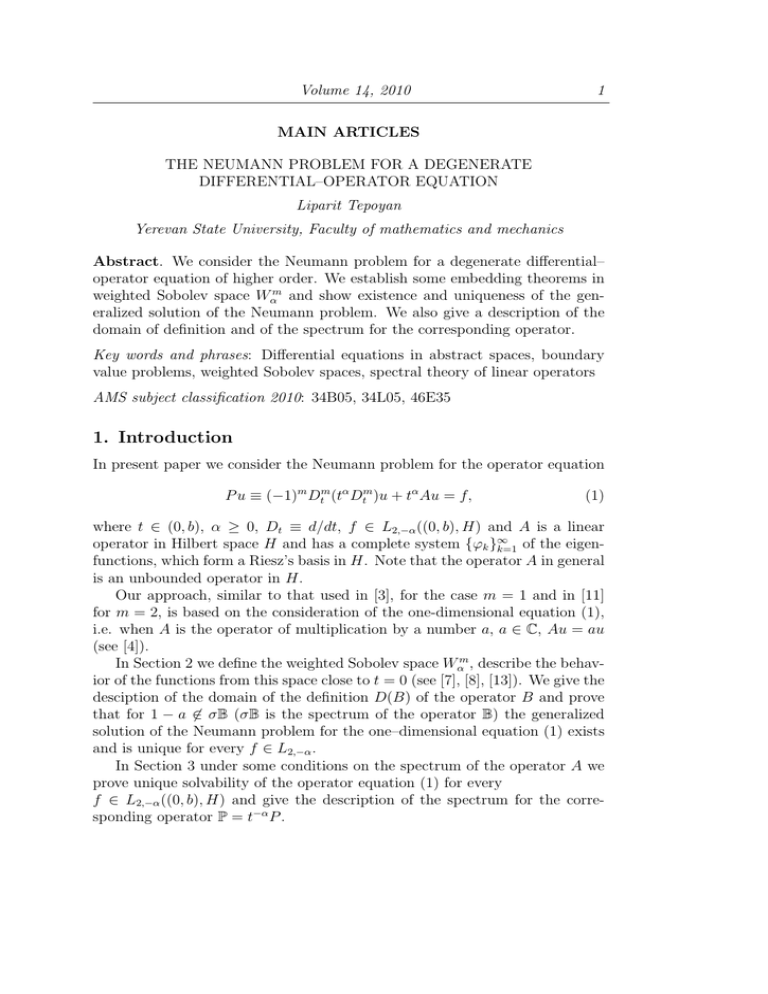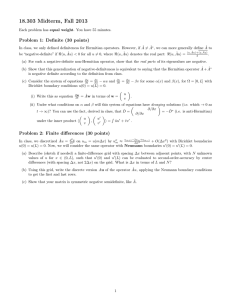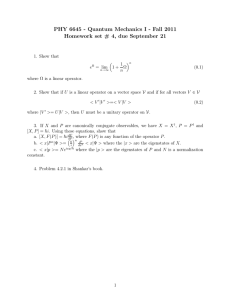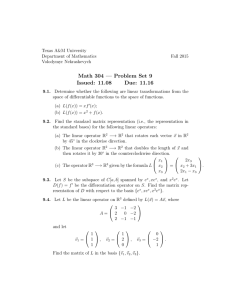Volume 14, 2010 1 Liparit Tepoyan
advertisement

Volume 14, 2010
1
MAIN ARTICLES
THE NEUMANN PROBLEM FOR A DEGENERATE
DIFFERENTIAL–OPERATOR EQUATION
Liparit Tepoyan
Yerevan State University, Faculty of mathematics and mechanics
Abstract. We consider the Neumann problem for a degenerate differential–
operator equation of higher order. We establish some embedding theorems in
weighted Sobolev space Wαm and show existence and uniqueness of the generalized solution of the Neumann problem. We also give a description of the
domain of definition and of the spectrum for the corresponding operator.
Key words and phrases: Differential equations in abstract spaces, boundary
value problems, weighted Sobolev spaces, spectral theory of linear operators
AMS subject classification 2010: 34B05, 34L05, 46E35
1. Introduction
In present paper we consider the Neumann problem for the operator equation
P u ≡ (−1)m Dtm (tα Dtm )u + tα Au = f,
(1)
where t ∈ (0, b), α ≥ 0, Dt ≡ d/dt, f ∈ L2,−α ((0, b), H) and A is a linear
operator in Hilbert space H and has a complete system {φk }∞
k=1 of the eigenfunctions, which form a Riesz’s basis in H. Note that the operator A in general
is an unbounded operator in H.
Our approach, similar to that used in [3], for the case m = 1 and in [11]
for m = 2, is based on the consideration of the one-dimensional equation (1),
i.e. when A is the operator of multiplication by a number a, a ∈ C, Au = au
(see [4]).
In Section 2 we define the weighted Sobolev space Wαm , describe the behavior of the functions from this space close to t = 0 (see [7], [8], [13]). We give the
desciption of the domain of the definition D(B) of the operator B and prove
that for 1 − a ̸∈ σB (σB is the spectrum of the operator B) the generalized
solution of the Neumann problem for the one–dimensional equation (1) exists
and is unique for every f ∈ L2,−α .
In Section 3 under some conditions on the spectrum of the operator A we
prove unique solvability of the operator equation (1) for every
f ∈ L2,−α ((0, b), H) and give the description of the spectrum for the corresponding operator P = t−α P .
2
Bulletin of TICMI
2. The One-dimensional Case
2.1. The space Wαm
Denote by Wαm the completion of C m [0, b] in the norm
∫ b
( α (m) 2
)
2
||u||Wαm =
t |u (t)| + tα |u(t)|2 dt.
(2)
0
For the proofs of the Propositions 1, 2 and Remark 3 see [2] and [13].
Proposition 1 For every u ∈ Wαm close to t = 0 we have
|u(j) (t)|2 ≤ (Bj + Cj t2m−2j−1−α )||u||2Wαm ,
(3)
where α ̸= 1, 3, . . . , 2m − 1, j = 0, 1, . . . , m − 1. For α = 2n + 1, n =
0, 1, . . . , m−1 in (3) the factor t2m−2j−1−α is to be replaced by t2m−2j−2n−2 | ln t|,
j = 0, 1, . . . , m − n − 1.
From Proposition 1 it follows that in the case α < 1 (weak degeneracy)
u (0) exist for all j = 0, 1, . . . , m − 1, while for α ≥ 1 (strong degeneracy)
not all u(j) (0) exist. More precisely, for 1 ≤ α < 2m − 1 the derivatives at zero
u(j) (0) exist only for j = 0, 1, . . . , sα , where sα = m − 1 − [ α+1
] (here [a] is the
2
(j)
integer part of a number a) and for α ≥ 2m − 1 all u (0), j = 0, 1, . . . , m − 1,
in general may be infinite.
(j)
Proposition 2 The embedding
Wαm ⊂ L2,α
(4)
Wαm ⊂ L2,β
(5)
is compact for every α ≥ 0.
Remark 3 The embedding
is compact for every α > 2m − 1 and β > α − 2m.
Observe that in the case β = α − 2m and α ≤ 2m − 1 the embedding (5)
fails (see [8]). For α ≤ 2m−1 we only have the embedding Wαm ⊂ L2,γ , γ > −1.
However, for α > 2m − 1 we have the embedding Wαm ⊂ L2,α−2m , which can be
proved by using of the Hardy inequality (see [6] and [8]) and this embedding
is not compact. Indeed, it is easy to verify, that for the bounded in Wαm
1 2m−α−1
1
1
sequence un (t) = n− 2 t 2 (ln t)− 2 − 2n φ(t), where φ ∈ C m [0, b], φ(t) = 1
for t ∈ [0, 2ε ], 0 < ε < min {1, b} and φ(t) = 0 for t ∈ [ε, b] doesn’t exist the
convergent in L2,α−2m subsequence (see [5], [12]).
Volume 14, 2010
3
2.2 One–dimensional Equation
Now we consider the Neumann problem for the special case a = 1 of the
one-dimensional equation (1)
Bu ≡ (−1)m (tα u(m) )(m) + tα u = f,
f ∈ L2,−α .
(6)
Definition 4 A function u ∈ Wαm is called a generalized solution of the
Neumann problem for the equation (6) if for every v ∈ Wαm we have
(tα u(m) , v (m) ) + (tα u, v) = (f, v),
(7)
where (· , ·) is the scalar product in L2 (0, b).
Proposition 5 The generalized solution of the Neumann problem for the
equation (6) exists and is unique for every f ∈ L2,−α .
The uniqueness of the generalized solution immediately follows from Definition
4. To prove the existence we note that the linear functional lf (v) = (f, v) is
continuous in Wαm because
|lf (v)| ≤ ||f ||L2,−α ||v||L2,α ≤ ||f ||L2,−α |||v||Wαm
and use Riesz’s lemma on the representation of continuous functionals.
If the generalized solution is classical then from (7) after integration by
parts we get
m
α (m) (m)
(−1) ((t u
)
m−1
∑
b
(−1)j ((tα u(m) (t))(j) v (m−j−1) (t))0 +(tα u, v) = (f, v).
, v)+
j=0
Since the function v ∈ Wαm is arbitrarily we conclude that the function u(t)
fulfills the following conditions (see [10])
(tα u(m) (t))(j) t=0 = u(m+j) (t)t=b = 0, j = 0, 1, . . . , m − 1.
(8)
For α = 0 the conditions (8) are usual Neumann conditions, which are of
Sturm type and, therefore, regular (see [9]).
Definition 6 We say that u ∈ Wαm belongs to D(B), if the equality (7) is
satisfied for some f ∈ L2,−α . In this case we will write Bu = f .
According to Definition 6 we have an operator
B : D(B) ⊂ Wαm ⊂ L2,α → L2,−α .
If u ∈ Wαm we know that u(j) (0), j = 0, 1, . . . , m − 1 exist only for α < 2m −
2j − 1 (see Proposition 1). But for the generalized solution of the equation (7)
we can improve it and give the following description of u ∈ D(B).
4
Bulletin of TICMI
Proposition 7 The domain of definition of the operator B consists of the
functions u ∈ Wαm for which u(j) (0) are finite for 0 ≤ α < 2m − 2j and
2m − 1 ≤ α < 4m − 2j − 1. The value u(0) is finite for 0 ≤ α < 2m + 1.
The values u(j) (0) cannot be specified arbitrarily, but are determined by the
right-hand side of (7).
Proof. To describe the domain of definitions D(B) of the operator B first
note, that tα u ∈ L2,−α since u ∈ L2,α . Hence it is enough to study the behaviour of the solutions for the equation (−1)m (tα u(m) )(m) = f, f ∈ L2,−α near
to the point t = 0. Let α ≥ 2m − 1. For the solution u(t) of this equation we
have
∫
(−1)m t−α t
(m)
−α
u (t) = t Pm−1 (t) +
(t − τ )m−1 f (τ ) dτ,
(9)
(m − 1)! 0
where Pm−1 (t) = a0 + a1 t + · · · + am−1 tm−1 is the polynomial of the degree
m − 1. Since u ∈ Wαm we have that Pm−1 (t) = 0. Hence we can write
∫
(−1)m t−α t
2m−1−α
α
(m)
m−1 α
−
|u (t)| = (t − τ )
τ 2 τ 2 f (τ ) dτ ≤ c||f ||L2,−α t 2 ,
(m − 1)! 0
therefore, integrating u(m) (t) (m − j)-times, j = 0, 1, . . . , m − 1, we get for
some polynomial Qm−j−1 of the degree m − j − 1
∫ t
1
(j)
m−j−1 (m)
|u (t)| = Qm−j−1 (t) +
(t − τ )
u (t) dτ ≤
(m − j − 1)! 0
≤ cj + dj ||f ||L2,−α t
2m−1−α
+m−j
2
= cj + dj ||f ||L2,−α t
4m−2j−1−α
2
.
Let now 2m−2j −1 ≤ α < 2m−2j +1, j = 1, 2, . . . , m−1. Then in the equality
(9) a0 = a1 = . . . = am−j−1 = 0 since u ∈ Wαm . The second term in (9) we have
already estimated and it exists for α < 2m − 1. Now it is enough to estimate
only first term after integrating u(m) (t) (m − j)-times. The main term after
integration remains cm−j t2m−2j−α , therefore for the existence of u(j) (0) we get
the condition 2m − 2j − α > 0, i.e., α < 2m − 2j. Note that for other values of
α the existence of the values u(j) (0) is proved in Proposition 1 (see [13]). Note
also that the conditions in Proposition 7 are exact, i.e., if we take for example
α = 2m − 2j, then the statement is false, the value u(j) (0) in general doesn’t
exist. To get an operator in the same space we set g(t) = t−α f (t). It is evident
that g(t) belongs to L2,α and ||f ||L2,−α = ||g||L2,α . Therefore, we get an operator
B ≡ t−α B : D(B) = D(B) ⊂ Wαm ⊂ L2,α → L2,α with Bu = g .
Proposition 8 The operator B : L2,α → L2,α is positive and selfadjoint.
Moreover, the inverse operator B−1 : L2,α → L2,α is compact.
Proof. The self–adjointness of the symmetric operator B (symmetry and
positivity of the operator B follow from the Definition 6) is a consequence of
Volume 14, 2010
5
the existence of the generalized solution for every f ∈ L2,−α (see [4]). Now
using (2) and the equality (7) with v = u we get
||u||2Wαm = (f, u) ≤ ||f ||L2,−α ||u||L2,α ≤ ||g||L2,α ||u||Wαm ,
and, therefore, we have
||u||L2,α ≤ ||Bu||L2,α .
(10)
The compactness of the operator B−1 : L2,α → L2,α now follows from the
inequality (10) and Proposition 2. Corollary 9 The operator B has a discrete spectrum, and the system of
the corresponding eigenfunctions is dense in L2,α .
This follows from the connection of the spectra of the operators B and B−1
and from the properties of compact selfadjoint operators (see [4]).
Note that if λ is an eigenvalue and u(t) a corresponding eigenfunction of
the operator B then we have
(−1)m (tα u(m) )(m) + tα u = λtα u.
(11)
It follows then from the inequality (10) and Definition 6 that λ ≥ 1. Note that
the number λ = 1 is an eigenvalue for the operator B with the multiplicity m
since every polynomial of order m − 1 is an eigenfunction. Therefore, for the
solvability of the equation
(−1)m (tα u(m) )(m) = f,
f ∈ L2,−α ,
(12)
we get the following result:
Proposition 10 The generalized solution of the Neumann problem for the
equation (12) exists if and only if (f, Pm−1 (t)) = 0 for any polynomial Pm−1 (t)
of order m − 1.
Here we have used both (g, Pm−1 (t))α = (f, Pm−1 (t)) since tα g(t) = f (t)
( (·, ·)α is the scalar product in L2,α ) and the definition of the operator B.
Note that the generalized solution of the Neumann problem for the equation
(12) is unique up to an arbitrary additive polynomial of order m − 1.
Now we can consider the general case of the one-dimensional equation (1)
P u ≡ (−1)m (tα u(m) )(m) + atα u = f,
f ∈ L2,−α ,
(13)
because the number 1 − a can be regarded as a spectral parameter for the
operator B. Therefore, we can state that if 1 − a ̸∈ σB then the equation (13)
is uniquely solvable for every f ∈ L2,−α .
6
Bulletin of TICMI
3. The Operator Equation
In this section we consider the operator version of the equation (1)
P u ≡ (−1)m Dtm (tα Dtm )u + tα Au = f,
f ∈ L2,−α ((0, b), H),
α ≥ 0. (14)
Suppose that the operator A : H → H has a complete system of eigenfunctions
N, forming a Riesz’s basis in H (see [4]), i.e., for
{φk }∞
k=1 , Aφk = ak φk , k ∈ ∑
every x ∈ H we have x = ∞
k=1 xk φk , and there are some positive constants
c1 and c2 such that
c1
∞
∑
|xk |2 ≤ ||x||2 ≤ c2
k=1
∞
∑
|xk |2 .
(15)
k=1
Hence for every u ∈ L2,α ((0, b), H), f ∈ L2,−α ((0, b), H) we have
u=
∞
∑
uk (t)φk ,
k=1
f=
∞
∑
fk (t)φk ,
k ∈ N.
(16)
k=1
Therefore, the operator equation (14) can be decomposed into an infinite chain
of ordinary differential equations
(m)
Pk uk ≡ (−1)m (tα uk )(m) + ak tα uk = fk ,
fk ∈ L2,−α ,
k ∈ N.
(17)
For the equations (17) we can define the generalized solutions uk (t), k ∈ N, of
the Neumann problem (see Section 2).
Definition 11 A function u ∈ L2,α ((0, b), H) is called a generalized solution of the Neumann problem for the equation (14) if the functions uk (t), k ∈ N,
in the representation (16) are generalized solutions of the Neumann problem
for the equations (17).
Proposition 12 The operator equation (14) is uniquely solvable for every
f ∈ L2,−α ((0, b), H) if and only if the equations (17) are uniquely solvable for
every fk ∈ L2,−α , k ∈ N, and the inequalities
||uk ||L2,α ≤ c||fk ||L2,−α
(18)
are satisfied uniformly with respect to k ∈ N.
For the proof of Proposition 12 see [4].
Let the numbers λ1 = 1 < λ2 < · · · < λk < · · · , λk → +∞ when k → ∞,
are the eigenvalues of the operator B (see Section 2). Suppose that
ρ(1 − ak , λm ) > ε,
k, m ∈ N,
where ε > 0 and ρ is the distance in the complex plane.
(19)
Volume 14, 2010
7
Theorem 13 Under the condition (19) the generalized solution of the Neumann problem for the operator equation (14) exists and is unique for every
f ∈ L2,−α ((0, b), H).
First note that under the condition (19) the equations (17) are uniquely
solvable for every fk ∈ L2,−α , k ∈ N and the inequalities (18) are satisfied.
Now the proof of Theorem 13 follows from Proposition 12.
Let g = t−α f, f ∈ L2,−α ((0, b), H). Then g ∈ L2,α ((0, b), H) and we define
an operator
P ≡ t−α P : D(P) = D(P )⊂L2,α ((0, b), H) → L2,α ((0, b), H),
with Pu = g in L2,α ((0, b), H). It follows from the condition (19) that for the
generalized solution of the Neumann problem we have
||u||L2,α ((0,b),H) ≤ c||g||L2,α ((0,b),H) .
(20)
The operator P−1 : L2,α ((0, b), H) → L2,α ((0, b), H) in general is not compact
in contrast to Proposition 8 (it will be compact only in the case when the
space H is finite-dimensional). If the operator A : H → H is selfadjoint we
can describe the spectrum of the operator P.
Proposition 14 The spectrum of the operator P is equal to the closure of
the direct sum of the spectra σB and σ(A − I), i.e.,
σP = σB + σ(A − I) ≡ {λ1 + λ2 − 1 : λ1 ∈ σB, λ2 ∈ σA}.
The proof of Proposition 14 immediately follows from the equality
P = B ⊗ IH + IL2,α ⊗ (A − I)
(here ⊗ means the tensor product of the operators). Note that here we use
the assertion, that if λ ∈ σT for the selfadjoint operator T in some separable
Hilbert space T : X → X, then there is some sequence xn ∈ D(T ), n ∈
N, ||xn || = 1 such that (T − λ)xn → 0, n → ∞ (see [1], [14]).
References
[1] J. M. Berezanski, Expansion in Eigenfunctions of Selfadjoint Operators, Transl.
Math. Monographs 17, American Mathematical Soc., Providence, 1968.
[2] V. I. Burenkov, Sobolev Spaces on Domains, Teubner, 1999.
[3] A. A. Dezin, Degenerate operator equations, Math. USSR Sbornik, 43, no. 3 (1982),
287–298.
[4] A. A. Dezin, Partial Differential Equations (An Introduction to a General Theory of
Linear Boundary Value Problems), Springer, 1987.
[5] P. A. Djarov, Compactness of embeddings in some spaces with power weight, Izvestya
VUZ–ov, Matematika, 8 (1988), 82–85 (Russian).
[6] G. H. Hardy, J. E. Littlewood, G.Polya, Inequalities, Cambridge Univ. Press, Cambridge, 1964.
8
Bulletin of TICMI
[7] L. D. Kudryavtzev, On a variational method of determination of generalized solution of differential equations in the function spaces with power weight, Differentsial’nye
Uravneniya , 19, no. 10 (1983), 1723–1740 (Russian).
[8] L. D. Kudryavtzev, On equivalent norms in the weight spaces, Trudy Mat. Inst.
Steklov., 170 (1984), 161–190 (Russian).
[9] M. A. Neumark, Lineare Differentialoperatoren, Akademie Verlag, Berlin, 1965.
[10] R. E. Showalter, Hilbert Space Methods for Partial Differential Equations, Electronic Journal of Differential Equations, Monograph 01, 1994.
[11] L. Tepoyan, Degenerate fourth–order diffeential-operator equations, Differentsial’nye
Uravneniya , 23, no. 8 (1987), 1366–1376 (Russian); English Transl. in Amer. Math. Soc.,
no. 8 (1988).
[12] L. Tepoyan, On a degenerate differential–operator equation of higher order, J. Contemp. Math. Anal. 34 (1999), no. 5, 48-56 (2000); translated from Izv. Nats. Akad. Nauk
Armenii Mat. 34 (1999), no. 5, 26–33 (Russian. English, Russian summary).
[13] L. Tepoyan, The mixed problem for a degenerate operator equation, Bulletin of
TICMI (Tbilisi International Centre of Mathematics and Informatics), 12 (2008), 15-29.
[14] J. Weidmann, Lineare Operatoren in Hilberträumen, Teil 1, Grundlagen, Teubner
Verlag, Stuttgart, 2000.
Received 15.01.2010; revised 16.05.2010; accepted 22.09.2010





